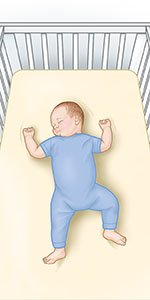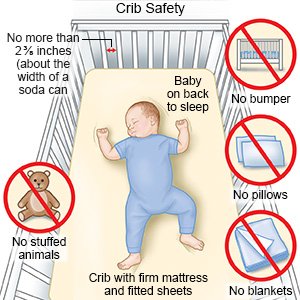SIDS (Sudden Infant Death Syndrome)
Medically reviewed by Drugs.com. Last updated on Aug 4, 2025.
Sudden infant death syndrome (SIDS) is the sudden death of a sleeping baby younger than 1 year old. The death cannot be explained even after a review of the baby's health history, surroundings, and autopsy results. SIDS is one type of sudden unexpected infant death (SUID). SIDS is more common among boys and peaks between 2 and 4 months of age. It is also more common during late fall and winter. A baby born at a low birth weight or who recently had a fever or infection is also at higher risk.
DISCHARGE INSTRUCTIONS:
Call your baby's doctor if:
- You have questions or concerns about how to put your baby to bed safely.
How to lay your baby down to sleep:
It is very important to lay your baby down to sleep in safe surroundings. This can greatly reduce his or her risk for SIDS. Tell grandparents, babysitters, and anyone else who cares for your baby the following rules:
- Put your baby on his or her back to sleep. Do this every time your baby sleeps (naps and at night) until he or she reaches 1 year of age. Do this even if your baby sleeps more soundly on his or her stomach or side.

- Put your baby on a firm, flat surface to sleep. Your baby should sleep in a crib, bassinet, or play yard that meets the Consumer Product Safety Commission (CPSC) safety standards. Make sure the slats of a crib are no wider than 2⅜ inches and that there are no drop-side rails. Do not let your baby sleep on pillows, waterbeds, soft mattresses, quilts, beanbags, or other soft surfaces. Never let him or her sleep on a couch or recliner. Move your baby to his or her bed if he or she falls asleep in a car seat, stroller, or swing. Your baby may change positions in a sitting device and not be able to breathe well.

- Put your baby in his or her own bed. A crib or bassinet in your room, near your bed, is the safest place for your baby to sleep. Never let him or her sleep in bed with you. Experts recommend that you have your baby sleep in your room for his or her first 6 months of life. This will help decrease the risk of SIDS. It will also make it easier for you to feed and comfort your baby.
- Do not leave soft objects or loose bedding in your baby's crib. His or her bed should contain only a firm mattress covered with a fitted bottom sheet. Use a sheet that is made for the mattress. Do not put pillows, bumpers, comforters, or stuffed animals in his or her bed. Dress your baby in a sleep sack or other sleep clothing before you put him or her down to sleep. Avoid loose blankets. If you must use a blanket, tuck it around the mattress.
- Do not let your baby get too hot. Keep the room at a temperature that is comfortable for an adult. Never dress your baby in more than 1 layer more than you would wear. Do not cover his or her face or head while he sleeps. Your baby is too hot if he or she is sweating or his or her chest feels hot.
- Do not raise the head of your baby's bed. Your baby could slide or roll into a position that makes it hard for him or her to breathe.
Decrease the risk for SIDS:
- Breastfeed your baby. Experts recommend that you feed your baby only breast milk until he or she is 6 months old. Always put your baby back in his or her own bed after you breastfeed him or her at night.
- Give your baby a pacifier when you put him or her down to sleep. Do not put it back in his or her mouth if it falls out after he or she is asleep. Do not attach the pacifier to a string. If your baby rejects the pacifier, do not force him or her to take it. If your baby breastfeeds, wait until he or she is breastfeeding well or is 1 month old before you offer a pacifier.
- Do not smoke or allow others to smoke around your baby. Also do not let anyone smoke in your home or car. The smoke gets into your furniture and clothing, and this means your baby is breathing smoke. This increases his or her risk for SIDS.
- Do not buy products that claim to reduce the risk of SIDS. Examples are sleep wedges and sleep positioners. There is no evidence that these products are safe.
If your baby's head is flat from sleeping on his or her back:
The back of your baby's head may be flat for a period of time. Your baby's head will round out as he or she gets older. Your baby will become able to hold his or her head up and spend less time on his or her back. The following may help limit the amount of pressure that is placed on the back of your baby's head:
- Alternate the direction your baby's face is turned when you lay him or her in bed. The flat spot will most likely get better or go away when he or she begins to sit up and crawl.
- Change your baby's positions while he or she is awake. Limit the amount of time your baby spends in swings, bouncy chairs, and car seats. These put added pressure on the back of your baby's head.
- Give your baby tummy time. Place your baby on his or her tummy daily when he or she is awake. This helps prevent a flat spot and also strengthens your baby's head, neck, and arm muscles. Do not leave the room when your baby is on his or her tummy.
Follow up with your baby's doctor as directed:
Follow-up appointments will help the provider learn if your baby has health problems that need treatment. Your baby may receive vaccinations during these visits. Write down your questions so you remember to ask them during your visits.
For support and more information:
- National Sudden and Unexpected Infant/Child Death and Pregnancy Loss Resource Center
2115 Wisconsin Ave. NW, Ste 601
Washington , DC 20007
Phone: 1- 202 - 687-7466
Web Address: www.sidscenter.org
- First Candle
1314 Bedford Avenue, Suite 210
Baltimore , MD 21208
Phone: 1- 800 - 221-7437
Web Address: http://www.firstcandle.org
- Cribs for Kids
810 River Avenue, Suite 250, Riverfront Place
Pittsburgh , PA 15212
Phone: 1- 888 - 721-2742
Web Address: http://cribsforkids.org
© Copyright Merative 2025 Information is for End User's use only and may not be sold, redistributed or otherwise used for commercial purposes.
The above information is an educational aid only. It is not intended as medical advice for individual conditions or treatments. Talk to your doctor, nurse or pharmacist before following any medical regimen to see if it is safe and effective for you.
Further information
Always consult your healthcare provider to ensure the information displayed on this page applies to your personal circumstances.
